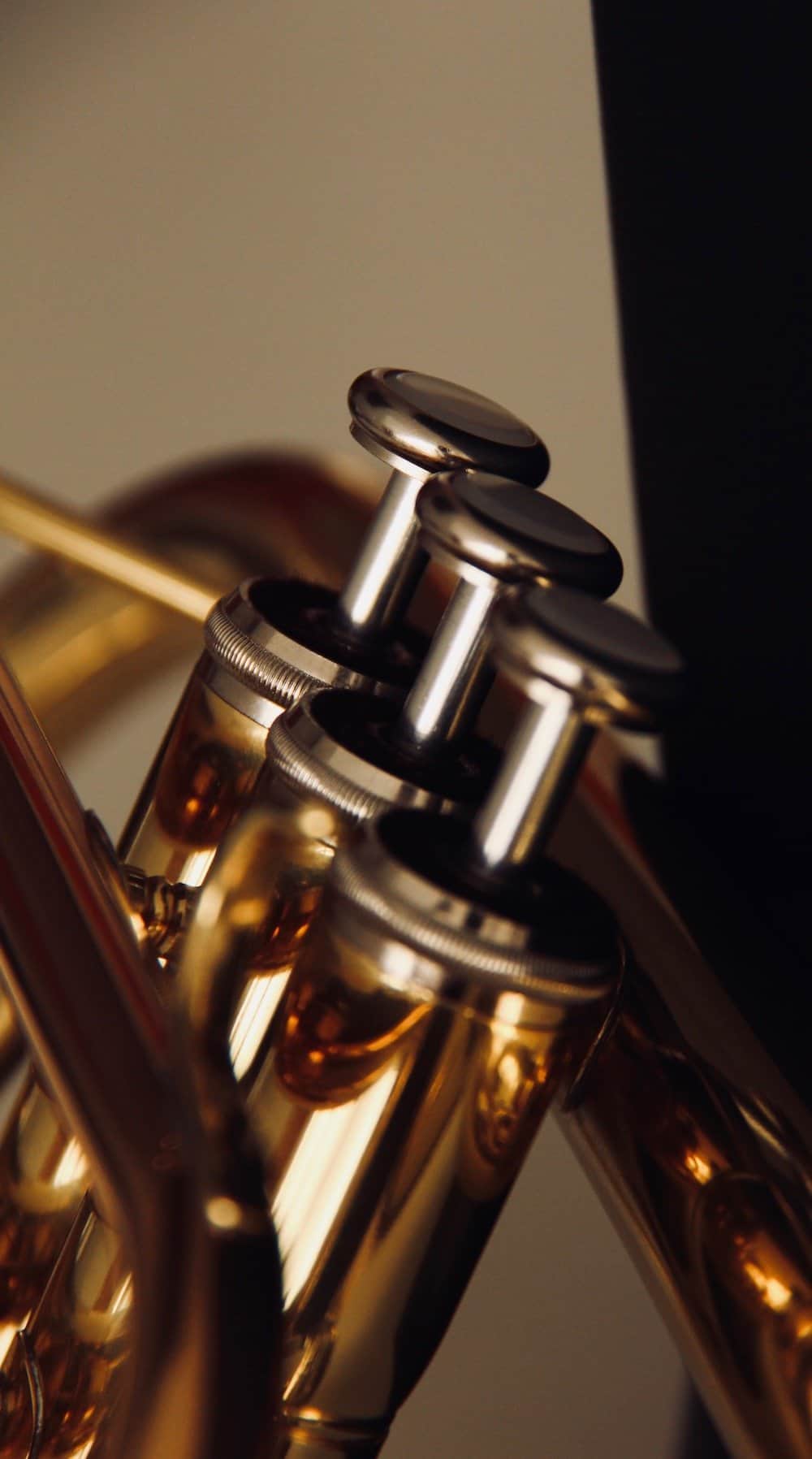Here are some of the most common problems when getting started learning trumpet:
Learning Trumpet: Common Problems
- Air won’t move through the trumpet at all.
- My valve is “wobbly”.
- Something is stuck in my Trumpet – I ‘m sure of it.
- I have braces.
- I can’t make a sound.
- It hurts to play.
Air won’t move through the trumpet at all.
Assuming that there is nothing stuck in the mouthpiece or the horn you probably have one of the valves turned around inside it’s casing. Check that first. Try to gently turn the valve caps clockwise. If they don’t turn they’re probably in right. If one rotates and then clicks into place your problem could be solved. If you’ve had the valves out or, worse yet, apart you might have some detective work to do.
Most valves these days have plastic or metal guides that ride up and down in the valve casing. These guides have little tabs that fit neatly into slots in the casing and a quick look inside the casing should show you where the tabs line up. While you have a valve in your hand look for a number near the top. 1, 2 or 3 tells you which valve you have. #1 is closest to the mouthpiece and they are not interchangeable.
If a valve has come apart read on.
My valve is “wobbly”.
Valves will occasionally come apart. It’s not a normal result of playing but it happens a lot in Middle Schools anyway because kids can’t help but fiddle with their valves. If the valve stem is wobbly you’re going to have to take the valve out and put it back together. Be careful and do it over a table or a desk or somewhere that will help you keep track of the parts that are going to fall out if you aren’t lucky. Without going into the variety of valve designs and parts and brands etc. etc. the easiest thing to suggest is that you carefully remove another valve – one that’s intact and use it as a model for fitting the parts back together.
Usually all that’s happened is that the valve stem has come unscrewed and needs to be screwed back together. If that’s it and you’re done follow the instructions above to put the valve back in. If the guts (the spring and the little plastic guide) have come apart the tricky bit is getting the little guide back in right side up and right way around. If there’s a thin plastic piece with tabs it goes into the slot sideways then you rotate it into position so that the grooved side holds the spring as it compresses. You also have to make sure that you don’t have it in backwards or the tabs will line the valve up backwards in it’s casing. To get this right look at the sample valve you took out. The numbers and tabs (narrow and/or wide) are generally consistent across the three valves. Some older valves have other guide systems so you’ll have to look closely at a working one to figure it out. It’s uncommon for the metal parts to break but the plastic guides can get munched. Repair shops usually have the most common ones on hand.
Something is stuck in my Trumpet – I’m sure of it.
If you think there’s something in there go back and check the valves again. If you know there’s something in there it’s time to play Doctor! First, Do no harm. I’ve damaged a number of instruments while trying to “fix” them and the most important technique I’ve developed is the ability to recognize when to stop and take it to a real repair person. If you’re feeling like a hammer or a pair of pliers might help it’s time to reconsider.
The odd time something like a marble will end up going in a bell and can be blown out with compressed air. There are two main risks: first that you’ll succeed and the object will come flying out hard and fast enough to damage someone or something: and second that instead of blowing out the problem you’ll create another one by blowing out a slide or blowing something into a valve. Either way there’s potential damage. Something stuck in there sounds like a visit to the shop. If your trumpet just has a little grunge in it that’s a simple cleaning and you’ll find that one the maintenance page if I’ve got there yet.
I have braces.
Lots of young players have managed years with braces. For all Trumpet players it’s a good idea to limit the amount of pressure you apply to the lips and for those with braces it’s crucial. You can get special wax for your braces that will reduce their sharpness and give you some relief. The concept of blowing your lips onto the mouthpiece rather than pulling the mouthpiece onto your lips might help too – and that’s good for all trumpet players. It encourages players to work more on their embouchure muscles, tongue arch, air support and air speed. Some players with braces find that using a larger mouthpiece, or one with a “cushion” or a Wedge rim helps.
I can’t make a sound.
Assuming that there is air going through the horn (see above) the next issue will be getting the lips to buzz in the mouthpiece. The buzz really matters so let’s get it going. Once you get it you won’t forget so here are some tricks.
#1 The Straw Trick requires a thin straw. It has to be thin enough to go through the hole in your mouthpiece. Some restaurants or coffee shops have these. (I got mine in a glass of water at a great little Sushi restaurant.) Stick the straw through the mouthpiece and into your mouth. Close your lips on the straw, hold the mouthpiece where it should be and while you’re blowing out pull the straw out and away. If you’re still blowing you should be buzzing. If not, try again a few times then move on to Trick #2. If you are buzzing start to play around with that buzz. Go higher and lower, make the old fashioned siren sound and maybe buzz Hot Crossed Buns.
#2 The Raspberry Trick starts with nothing – no props, no mouthpiece.Lick your lips. Slide your top lip over your bottom lip. Take in a big breath and make a farting sound with your lips. (This isn’t school so we can use that word all we like.) As your lips flap flatulently (a big word for farts) slide your lips so that the lower lip comes up over the top lip. Keep the fart sound going. Do this a few times and try to raise the pitch of the sound. To keep the analogy intact you’re trying to make the sound go from a big room-clearing lumberjack fart to a tiny squeaker. Is that graphic enough? Once you’ve played around with that for a bit put the mouthpiece on it and see what you get. It should be something better than what you were getting.
I Can Get a Sound but it’s Really Low and Ugly
If the air is moving through the Trumpet, and you’re getting a really low, grumbly sound that seems way lower than anything like a Trumpet should sound click here.
It hurts to play.
It’s never safe to assume, but let’s do that. I’ll assume that you’re sitting or standing with reasonably good posture and that your instrument works properly. If your arms hurt from holding up the trumpet you’ll get stronger. If you’re tiny and it’s really too big all I can suggest is a Cornet or possibly a Pocket Trumpet but either way that could cost money that you might not have.
If your lips hurt that’s something to deal with. If they feel kind of “buzzy” that’s normal and isn’t going to hurt you. If the muscles at the side ache after you’ve played for a while that’s good. It means they’ve worked and are getting stronger. If the place where the mouthpiece sits feels like it got hit with a heavy piece of metal then that’s a problem. The problem is that it got hit with a heavy piece of metal. The solution is to use WAY LESS PRESSURE. Your arms are big and strong and capable of putting WAY TOO MUCH PRESSURE on your lips.
If your lips hurt today you’re done for the day. Tomorrow you will start to play much more gently and for not too long. What you need is to retrain yourself to use as little pressure as possible while still making a sound. Don’t worry much about the quality of that sound, just practice playing with almost no pressure. Don’t play high notes and don’t play loud – just play. You should be taking breaks that add up to more time than your playing time. (That’s why I write so much – I’m practising but IO’m on a break.) Play long, low, gentle notes with a steady flow of air from the big breaths you’re taking between long rests.
Work on lips slurs between the two lowest notes in any given fingering and ask your wind speed and side lip muscles to do the work. If your right pinky is in the finger hook on your Trumpet’s leadpipe take it out. Leave it out whenever you play. Its only purpose is to free up the other hand to turn pages or empty your spit valves or whatever. It’s not there so that you can pull the Trumpet harder onto your face.
Next Problem
I’ll keep adding these and hopefully get to yours!

